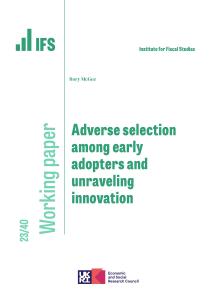The government has recently consulted on the structure of alcohol taxes. This consultation focuses on two issues: (i) the introduction of a new still cider and perry band that would increase the tax on products below 7.5% ABV, and (ii) the introduction of a new still wine band that would reduce the tax on products between 5.5% and 8.5% ABV.
In this Observation we summarise our main points from our response to the consultation (which is reproduced in full at the end of this piece).
The main rationale for subjecting alcohol to additional taxes above and beyond VAT is that there are social costs of drinking that are not taken into account by the drinker themselves. These costs include the public costs of treating alcohol-related diseases and dealing with alcohol fuelled crime. The aim of taxation should be to raise the price paid by the drinkers who generate these social costs by an amount equal to the (marginal) social cost of drinking an extra drink.
Ideally, taxes would be levied per unit of pure alcohol (ethanol), as it is the alcohol that creates social costs. However, restrictions imposed by the European Union mean that cider and wine must be taxed per litre of product. This means that for a given tax rate per litre of product, higher strength products (those that contain more pure alcohol per litre of product) face a lower per unit of alcohol tax rate. This restriction is one motivation for introducing additional tax bands for mid-strength cider and low-strength wine.
In light of this, our view on the proposed modest reforms are summarised as follows:
- The introduction of a new cider and perry band is a small movement in the right direction. However, the proposed small tax increase would still leave the tax levied on cider and perry at a much lower level than that levied on other alcohol products.
- The tax rates on cider should be brought in line with beer. Currently, a litre of 7.5% cider attracts less than a third of the tax of a litre of 7.5% beer. This provides an incentive for people to choose cider over beer, and to consume more alcohol, than if cider were taxed at the same rate as beer is currently taxed. This equalisation of rates does not necessarily mean increasing the tax applied to cider to beer tax levels. One possibility would be to increase the tax on cider and reduce the tax on beer to equalise them in a revenue neutral way.
- The argument that cider is part of the rural economy is not a good reason for subjecting cider to a lower rate of tax. Alcohol taxes should be designed to deter socially costly overconsumption of alcohol. If there are reasons to subsidise the cider industry over the beer, or other industries, then appropriate policy instruments should be designed to do this. However, it is not clear why the cider industry needs government assistance, potentially at the expense of other alcohol – or rural – industries in the UK.
- There are currently virtually no still wine products sold off-trade with an ABV less than 8.5%. This part of the market would have to increase several-fold to have any impact on total alcohol consumption.
Overall this represents a missed opportunity for a more comprehensive review of how alcohol is taxed in the UK. The annex to this Observation contains our responses to selected questions in the consultation (shown in bold).











